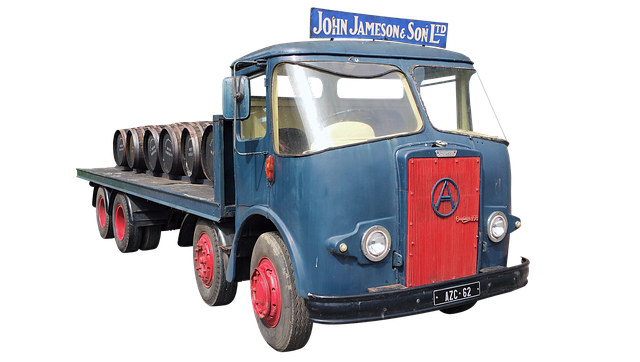Looking to register your car in California? This comprehensive guide walks you through every step, from understanding state requirements to securing your vehicle registration. First, familiarize yourself with California’s car registration mandates, then gather essential documents for a seamless DMV visit. Learn the importance and process of performing a VIN (Vehicle Identification Number) verification, complete the application, pay fees, and obtain your official papers. Remember, a successful registration hinges on accurate documentation and proper dmv vin verification.
- Understand California Car Registration Requirements
- Gather Necessary Documents for DMV Visit
- Perform VIN Verification: Steps and Importance
- Complete Application Process at the DMV Office
- Pay Fees and Obtain Your Vehicle Registration Papers
Understand California Car Registration Requirements

Before registering your car in California, it’s crucial to understand the state’s specific requirements for vehicle registration and the role that a DMV VIN verification plays in this process. California’s Department of Motor Vehicles (DMV) mandates that all vehicles operating within the state be properly registered and have undergone necessary inspections to ensure roadworthiness and safety. The Vehicle Identification Number (VIN) is a critical component in this verification process.
A DMV VIN verification ensures that your vehicle matches the information on file with the manufacturer, helping to prevent fraud. This typically involves a mobile VIN inspection where an authorized agent from the DMV or a third-party provider uses the unique VIN to cross-reference data with the manufacturer’s records. As part of the registration process, you’ll need to provide proof of this verification to demonstrate that your vehicle meets California’s safety and environmental standards. Ensuring this step is completed accurately and promptly will help streamline the car registration process in California.
Gather Necessary Documents for DMV Visit

Before visiting the DMV to register your car in California, ensure you have all the essential documents ready. This process is crucial for a smooth and efficient transaction. You’ll need your vehicle’s registration certificate from the previous state (if applicable), proof of ownership, and a valid driver’s license or identification card. Additionally, the Department of Motor Vehicles (DMV) will require a Vehicle Identification Number (VIN) verification, which can be done through a mobile vin verifier or an inspection at their offices.
A vin inspection is a critical step in the registration process, as it helps verify the vehicle’s history and ensures it meets safety standards. Make sure to check your car’s VIN, usually found on the vehicle identification plate, and keep this number handy for reference during your DMV visit. This simple step can save you time and potential issues later on, especially when dealing with California’s stringent motor vehicle regulations.
Perform VIN Verification: Steps and Importance

Before you register your car in California, performing a Vehicle Identification Number (VIN) verification is a crucial step. This process involves checking the vehicle’s history and ensuring it meets all necessary standards. You can do this by visiting a DMV office or utilizing an online service that provides a dmv vin verification. This step is essential as it helps to prevent fraud, ensures safety, and confirms the vehicle’s authenticity.
The VIN inspection typically includes verifying the vehicle’s ownership history, checking for any outstanding recalls, and assessing its overall condition. For added convenience, some services offer mobile vin inspection or mobile vin verification, allowing you to complete this process from the comfort of your home or on-the-go. This is particularly beneficial when preparing to register a car in California, as it streamlines the initial verification step.
Complete Application Process at the DMV Office

To complete the car registration process in California, you’ll need to visit a local Department of Motor Vehicles (DMV) office. Here, you’ll fill out an Application for Title and Registration form, also known as Form DMV-123. This involves providing essential details about your vehicle, including its make, model, year, and unique Vehicle Identification Number (VIN). A crucial step in this process is the DMV VIN verification, ensuring the information on your car’s registration matches the vehicle’s specifications.
Staff at the DMV will guide you through the application, which includes uploading or providing physical proof of your car’s necessary documents, such as insurance and ownership records. Once all required forms are completed and verified, including a successful mobile vin inspection or in-person vin inspection, the DMV will issue your vehicle’s registration certificate, allowing you to legally operate your car on California roads.
Pay Fees and Obtain Your Vehicle Registration Papers

After completing the required forms and gathering all necessary documents, it’s time to pay the fees for your vehicle registration. The California Department of Motor Vehicles (DMV) will process your application and issue your official Vehicle Registration papers. This typically involves a fee for registration, which varies based on your vehicle type. You can often pay these fees online or in person at any DMV field office.
Ensure that you have undergone the essential dmv vin verification process, which includes a vin inspection to validate your vehicle’s identity. Consider using a mobile vin verifier for convenience and accuracy. This step is crucial before finalizing your registration as it helps to prevent fraud and ensures that your vehicle’s details match the records.
Registering a car in California involves understanding clear requirements, gathering essential documents, completing a VIN verification process through dmv vin verification, and submitting an application at a DMV office. Once approved, you’ll pay associated fees and receive your official vehicle registration papers. This straightforward process ensures legal compliance and allows you to hit the road with confidence.
